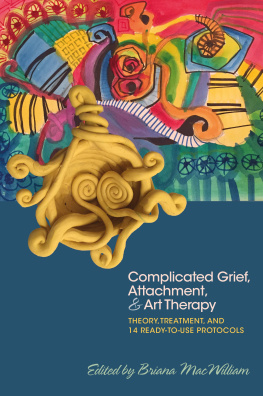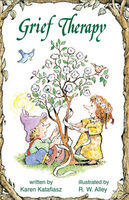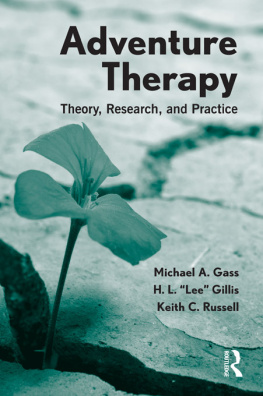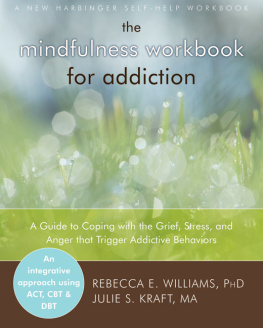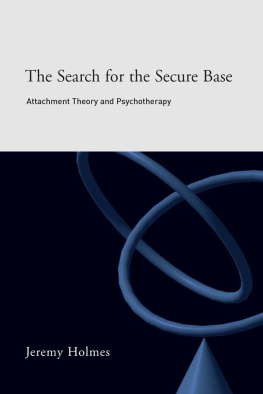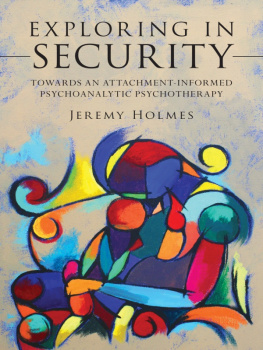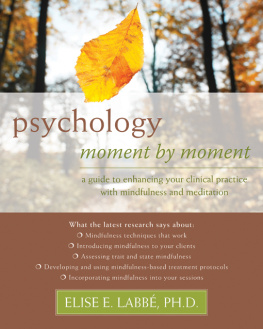
Complicated Grief,
Attachment,
& Art Therapy
Theory, Treatment, and
14 Ready-to-Use Protocols
Edited by Briana MacWilliam

Jessica Kingsley Publishers
London and Philadelphia
Contents
Introduction
Briana MacWilliam
Intersections of attachment and grief
The meaning making of memories, the weaving of symbol into story: this is the work of grief. In the therapeutic practice of the art therapist, it is essential to understand the healing aspects of this process, when exploring how disturbances in attachment impact grief and loss.
Attachment is a biopsychosocial process by which affectional bonds are formed between human beings, most critically examined through the earliest phases of development. What qualifies as a disturbance is further explored throughout this text, but generally speaking, when a child receives such messages as you make me proud, you make me angry, or dont hurt your sisters feelings, he realizes the power he wields over othersincluding his more capable adult caretakersand this is anxiety inducing. Equally, he realizes the opposite must be true: if he can make others feel something and act accordingly, then they can make him feel something and act accordingly as well. In this way, the child falls into blame games that quickly spiral into complicated relationships, fraught with tension and unresolved issues. He then carries those loose ends into other aspects of life, compounding his unfinished business (James and Friedman, 2009).
Finally, when a great loss occurs, the child is put to the task of unwinding this tangled web for himselfa responsibility he must learn, perhaps, for the first time in his life. No, you cannot control the rain that ruined your picnic, or the delayed flight that cost you a promotion, or the philandering activities of your ex-boyfriend, or the abusive nature of your stepfather, or the cancer that killed your mother, nor the car accident that took your child, but you can control how you move on from it. You can make a decision about how these horrible events will continue to shape your experience of the present moment. It is bad enough when terrible things happen to us, but to succumb to these events and their influence through self-inflicted perpetuity is to always feel pain.
Easier said than done, you might say, and you would be right. But it begins with making the choice, with realizing that holding onto a lovely fantasy that only causes you heartache is not a way of honoring the dead or the lost, but a form of self-punishment. Equally, beating yourself up over things you might have said or done, or failed to say and do, is to place the work of forgiveness in other peoples hands, and absolve yourself of responsibility. In this vein, the work of grief is the work of growth, defined by a revisiting and revising of our attachments, through the process of integration. It is a choice between contracting into a victimized identity, or discovering grace on the other side of helplessness and surrender (Tolle, 2004).
What is integration? In essence, integration is how we observe, understand, interact with, create, and communicate our life story. Integration has been defined through various stage theories, models of change and research methodologies, many of which you will find illuminated in this text. Less important is discerning which of these approaches to dealing with grief is the right one; more important is discovering which one resonates for the individual. Like a thumbprint, no two persons are the same, and so it is with how we make meaning of our stories. Integration is the work of discovering what is ours, and what was given to us. What we want to keep and what we want to change. It is not finding the missing pieces of a puzzlewe are already whole and always have beenit is a reshaping of the puzzle to include all the pieces that need fit.
Integration doesnt happen overnight. Relying solely on time to heal a wound, however, inadequately bandages an untreated infection. Only through a concerted effort to confront the depths of our pain and the origins of its structure is it possible to feel the sun on our face. In C.S. Lewiss (1961, pp.5253) A Grief Observed he notes, there was no sudden transition from fear, anger, grief and pain to warmth and light. It was like the warming of a room or the coming of daylight. When you first notice them, they have been already going on for some time.
Art therapy and short-term treatment
If the work of integration is equivalent to reshaping our psychic puzzles to fit all the necessary pieces, then art therapy challenges us to create that puzzle in a tangible way. A theory may suggest a particular outcome based on an educated guess, but it is only through experimentation that an extraneous variable makes itself known, serving to validate, disprove and/or revise our original thinking. Through a willing suspension of disbelief, creative acts allow for this element of the unknown; we accept, for a moment, we dont know everything, and are willing to try a new way of perceiving. This suspension allows us to watch a film, read a book, gaze at an abstract painting, or play a song and experience emotional resonance, which may be derived of fictional content, but nonetheless helps us solve real life quandaries.
In the context of art therapy, we might refer to these extraneous variables as sensations, metaphors, images and/or personal symbols that bubble up from the unconscious to deliver their own critiques of our conscious self theories. It is the responsibility of the art therapist to contain, assist, and mirror, in this fantastic transitional space, what reconciliation lies between the clients inner and outer worlds (Winnicott, 1970). To meet this challenge, the art therapy student and working professional benefits from three things: knowledge of theory, an experiential understanding of its applications, and a mastery of implementation. Adhering to this philosophy, the content of this book was divided into three parts:
: Examines grief and attachment, including definitions and key terms, existing change and recovery models, a developmental framework, a biopsychosocialspiritual perspective, and a discussion of directive and non-directive art therapy approaches.
: Examines through the art-based self-studies of art therapists the intra-psychic journey of addressing the grieving process. Methods, procedures, and a discussion of themes are organized in an instructional manner for ease of replication.
: Examines through the implementation of art therapy interventions with various populations the observable journey of integration in the grieving process. Methods, procedures, and a discussion of themes are organized in an instructional manner for ease of replication.
According to its website, the American Art Therapy Association (AATA) represents more than 5000 professional art therapists across the globe (and others who hold the belief that the creative process involved in art making is healing and life enhancing). A survey conducted of its members in 2013 revealed over two-fifths (41.9%) of respondents work with Mood or Anxiety Disorders, and Posttraumatic Stress Disorder was chosen by 30.7 percent of respondents. The American Psychological Association offers four psychological effects of mood disorders and PTSD: depression, generalized anxiety, survivors guilt, and grief and loss. Additionally, risk factors for complicated grief, which is a prolonged, dysfunctional experience of grief, include being a woman, a history of mood disorders, low social supports, insecure attachment style, positive care giving with the deceased, and pessimistic temperament and personality correlatesall of which suggests common underlying vulnerability (Shear et al ., 2011). It is the argument of this author that the underlying vulnerability quite clearly relates to ones fundamental attachment dynamics, and this has predictive and possibly protective implications for the experience of grief.
Next page
